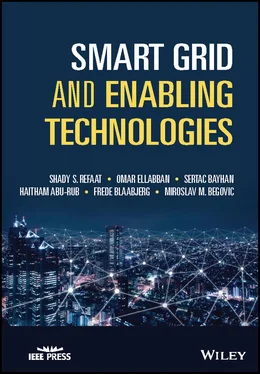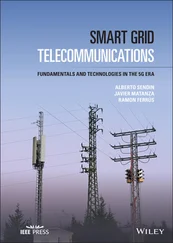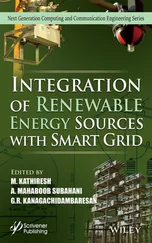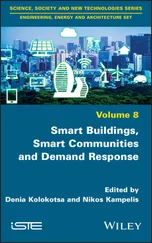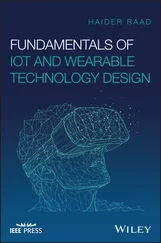Frede Blaabjerg - Smart Grid and Enabling Technologies
Здесь есть возможность читать онлайн «Frede Blaabjerg - Smart Grid and Enabling Technologies» — ознакомительный отрывок электронной книги совершенно бесплатно, а после прочтения отрывка купить полную версию. В некоторых случаях можно слушать аудио, скачать через торрент в формате fb2 и присутствует краткое содержание. Жанр: unrecognised, на английском языке. Описание произведения, (предисловие) а так же отзывы посетителей доступны на портале библиотеки ЛибКат.
- Название:Smart Grid and Enabling Technologies
- Автор:
- Жанр:
- Год:неизвестен
- ISBN:нет данных
- Рейтинг книги:3 / 5. Голосов: 1
-
Избранное:Добавить в избранное
- Отзывы:
-
Ваша оценка:
- 60
- 1
- 2
- 3
- 4
- 5
Smart Grid and Enabling Technologies: краткое содержание, описание и аннотация
Предлагаем к чтению аннотацию, описание, краткое содержание или предисловие (зависит от того, что написал сам автор книги «Smart Grid and Enabling Technologies»). Если вы не нашли необходимую информацию о книге — напишите в комментариях, мы постараемся отыскать её.
Smart Grid and Enabling Technologies
Smart Grid and Enabling Technologies
Smart Grid and Enabling Technologies — читать онлайн ознакомительный отрывок
Ниже представлен текст книги, разбитый по страницам. Система сохранения места последней прочитанной страницы, позволяет с удобством читать онлайн бесплатно книгу «Smart Grid and Enabling Technologies», без необходимости каждый раз заново искать на чём Вы остановились. Поставьте закладку, и сможете в любой момент перейти на страницу, на которой закончили чтение.
Интервал:
Закладка:

Figure 1.19 Technologies for the evolution of the SG.
1.10 Actions for Shifting toward Smart Grid Paradigm
The electric grid's modernization should begin with a careful assessment of existing technologies within the power grid. Proper utilization of the existing power plants, transmission, and distribution lines and other facilities are the key factor in accomplishing grid modernization within the available financial and technical resources. The country should determine its current level of technology deployment followed up with a focused financial study and analysis of missing grid modernization aspects and associate them with timeline and cost. There are specific analyses that should be conducted for shifting to the SG paradigm. Each utility should conduct its own different analyses and implement specific strategies within a defined timeline. Examples of required analyses are [74, 75]:
Gap analysis:refers to identifying the incomplete actions between current status and future targets to achieve the desired outcomes. Also, it identifies the gaps in a particular grid's technology evolution and developed pillars. This will be used in the development of any shortcomings, as well as the implementation plans. The next step is to assess the current status, concerns, degree of technology deployment, and success rate. The simple form of gap analysis is comparing the current situation to the objective statement for each focus technology and pillar. An example of the gap analysis on increased reliability and efficiency of electricity transmission and distribution system is shown in Figure 1.20.
Cost–benefit analysis:refers to the analysis that should be conducted to identify the associated cost of the actions in the various pillars that are necessary to mitigate the gaps which are identified in the gap analysis. This should be done to measure the physical performance of the application of the SG in a way that is quantifiable and with high certainty and accuracy. The cost‐effectiveness analysis takes a step further and provides scientifically based measurements and protocols to identify the physical impacts and monetary costs that come with the SG projects. The payback time for all sectors would then be identified which will help in promoting and adopting the SG paradigm at a very wide scale and get support from policymakers and market players.
Risk analysis:refers to the analysis conducted in order to identify the risks associated with taking actions in the various pillars. The risk assessment has an important role in the adopted SG road map in order to timely mitigate the associated risks.
Barrier analysis: refers to the conducted analysis to identify any potential barriers that must be overcome in adopting and achieving the SG era. These may relate to policies, regulations, technology, human resources, finances, etc.
1.10.1 Stages for Grid Modernization
The process of grid modernization can be divided into four main stages as shown in Figure 1.21. The requirements, benefits, and risks associated with each stage are summarized below. Also, individual countries and grids operators should have updated policies and regulations supporting the transformation to a SG.
Stage 0:Includes manual control and local automation with little local and remote automation.
Stage 1:Includes the substations automation and remote control to be built on stage 0 by adding intelligent electrical devices (IED), remote terminal units (RTU), streaming sensors, and data communication facilities to achieve local and remote monitoring and control capabilities at HV/MV/LV substations.
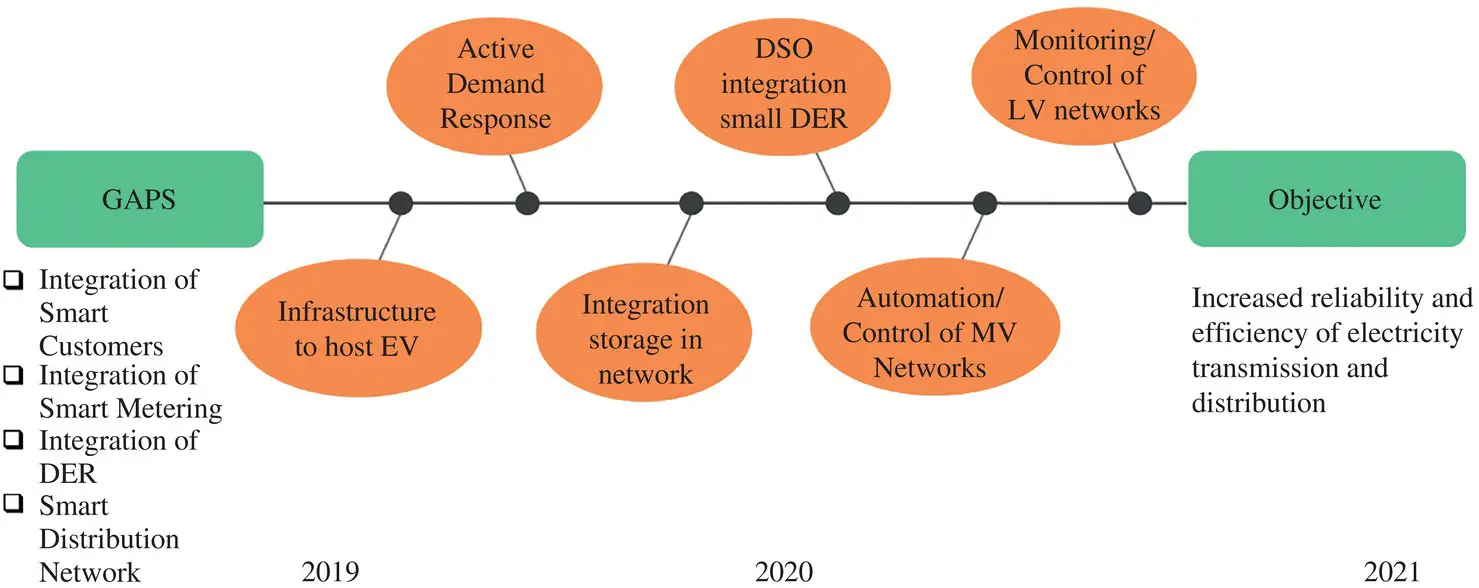
Figure 1.20 Fishbone diagram showing gaps.

Figure 1.21 The main stages for achieving grid modernization.
Stage 2:Includes feeder automation and remote control built on Stage 1 by extending remote monitoring and advanced control to the outgoing feeders. This stage includes information from communicating meters to large industrial customers for improved control, management, and decision making.
Stage 3:Includes large‐scale penetrations and integration for DER, control, and management with big data management analytics and distributed data centers, DR, and self‐healing application. Also, adding ES, static VAR sources, and developed communication and control facilities to successfully implement high penetrations of DERs on the distribution feeders. This stage of grid modernization also entails the use of AMI to achieve on‐demand reading of consumer meters along with DR capabilities. Also, adding the intelligent energy management system (IEMS) and home energy management system (HEMS) will help with improved control, management, and decision‐making.
SG implementation requires special support and mechanisms including economic incentives, technology‐specific actions, new policies, and feed‐in tariffs. Without these particular requirements, the grid will not fully satisfy the national energy sector goals and future generations' needs.
1.10.2 When a Grid Becomes Smart Grid
Seven principal characteristics are considered a must for any network to be declared as a “Smart Grid”:
1 Be self‐healing from power disturbance events (Self‐Healing).
2 Enable active participation by consumers in DR (Demand Response).
3 Operate resiliently against physical and cyber‐attacks (Resiliency and Immunity).
4 Provide power quality for twenty‐first century needs (21st Power Quality).
5 Accommodate any level and type of renewable generation and storage options.
6 Enable new technologies, products, services, and markets (Modern Services).
7 Optimize assets and operating efficiently (Optimal Asset Management).
1.11 Highlights on Smart Grid Benefits
Smart grid plays a critical role to enable the overall electric power sector objectives. The role of SG within the energy sector policies and regulations is shown in Figure 1.22. The general goals of SG are to ensure delivery of electric energy in an efficient, sustainable, resilient, and environmentally friendly manner. This allows for ambitious power sector targets that trigger new investment needs and call for new ways to control, manage and operate network infrastructures.
SG is therefore a conceptual goal whose achievement will require continuous grid modernization with the use of conventional and advanced technologies and operations. Through its pillars, SG provides great benefits to different parties connected to it. Utilities will gain reduced maintenance cost and lower distribution cost, while grid operators will ensure better monitoring and control capabilities which lead to greater efficiency and resiliency. Finally, consumers will gain better supply quality and continuity and will have control over their profile of consumed power and reduced electricity consumption. SG adaptation will benefit the nation and serve the environment by reducing electrical energy consumption, achieving continuous electricity supply, and ensuring clean and sustainable energy. The SG vision presents a power system that is more intelligent, more decentralized, and more controllable than today's grid. Integrating numerous intelligent SG technologies and operations in power generation, transmission and distribution are considered as the required trend for the energy paradigm shift.
Читать дальшеИнтервал:
Закладка:
Похожие книги на «Smart Grid and Enabling Technologies»
Представляем Вашему вниманию похожие книги на «Smart Grid and Enabling Technologies» списком для выбора. Мы отобрали схожую по названию и смыслу литературу в надежде предоставить читателям больше вариантов отыскать новые, интересные, ещё непрочитанные произведения.
Обсуждение, отзывы о книге «Smart Grid and Enabling Technologies» и просто собственные мнения читателей. Оставьте ваши комментарии, напишите, что Вы думаете о произведении, его смысле или главных героях. Укажите что конкретно понравилось, а что нет, и почему Вы так считаете.
